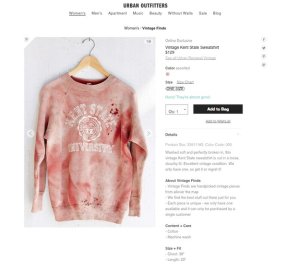As stated by Dr. Luttrell, from Social Media, “We can no longer argue that social media is on the rise or that it is in the early phases of adoption. Social media is here, and it is growing leaps and bounds.” That statement proved to be true after social media blew up today on multiple sites, such as Facebook, Twitter, and Instagram when Urban Outfitters launched a vintage Kent State University sweatshirt that had blood splatter on it. This $129 sweatshirt was emulating an infamous school shooting that happened in 1970, when four students were shot by National Guard after protesting the Vietnam War. Both Urban Outfitters and Kent State had something to say after the picture of the sweatshirt went viral. Now where to begin with this clothing disaster, I guess the idea behind the sweatshirt.

Vintage Kent State sweatshirt from Urban Outfitters website.
http://www.businessinsider.com%2Furban-outfitters-kent-state-sweatshirt-bloodstain-
Urban Outfitters has come out with a statement apologizing saying, ” It was never our intention to allude to the tragic events that took place at Kent State in 1970 and we are extremely saddened that this item was perceived as such. This one of-a-kind item was purchased as part of our sun-faded vintage collection. There is no blood on this shirt nor has this item been altered in any way. The red stains are discoloration from the original shade of the shirt and the whole are from natural wear and fray.” -Urban Outfitters spokesperson.
I guess I see two sides of this argument for Urban Outfitters and the public. First, for anyone who has either shopped in Urban Outfitters or seen their clothing in various outlets know that they have very outside the box clothing. I personally like there clothes and have many pieces from their collections. Although, this certain sweatshirt could be exactly what the company said about it, ” the red stains are discoloration from the original shade.” This certain garment really could just have that certain pattern on it, not meaning to portray a horrific event in American history. Having worked in the retail industry for nine years, I understand that the manufacturing can vary the results of how a clothing items looks. This brings me to my next point, why would Urban Outfitters allow for a garment to be on their shelves that gave customers the idea that emulated a gunshot wound to the arm, with blood splatter. This was a massive event that effected thousand that were involved in the protest, and those around the country. If a retailer wants to selling a college sweatshirt, its probably not in their best interest to sell it with blood stains and bullet holes on it, with a school logo that had a massive shooting.
Now, I am very conflicted on what to think about this sweatshirt. I shop frequently at Urban Outfitters, so much that I actually have a shopper tote. So does this make me a certain type of hypocrite for having so much of their products, but bad mouthing the company at times when no one wants to be associated with them? I feel that I am stuck in the middle of this trending social issue, but after reading the facts, I think that I am more disappointed in Urban Outfitters than anything else. Again, this is my personal opinion and I’m curious to know what your thoughts are on the matter?
This has not been the company’s first controversial clothing item, as it has battled criticism time and time again. Some of these items include from the week.com, pro-booze for kids, the Holocaust-evoking “Jewish Star” shirt,” Obama/Black” T-shirt, and the “Eat Less” T-shirt. I have a feeling that this will not be the last time Urban Outfitters will be in the news for outrageous and offensive clothing.
Due to the masses that flock to social media, it allowed for this story to be spread quickly to those over a multitude of sites. As an effect of social media being so profoundly used daily, this sweatshirt spread like wild fire. As chapter two stated media allows us to make channels through which we make connections with others in many forums. We can now connect through pictures, websites, and mobile devices. If we didn’t have this great social media source, I don’t think that this news of this sweatshirt would have spread as fast. Today, I saw this link being posted to numerous social media forums. This caused a chain reaction of outcries from a magnitude of people. Another piece that stood out to me from chapter two was, from Barlow saying, ” Internet has created a generation of people accustomed to finding their own answers, creating their own systems, forming their own new communities.” By Urban Outfitters creating this sweatshirt, it left an open-ended meaning for consumers. As a result of their actions, the internet allowed for the sweatshirt to be shared on social media sites and communities of people began to assume that they wanted to recreated something from the Kent State shooting.
From the Circular Model of SoMe for Social Communication, the four components: share, optimize, manage, engage were majorly used by Urban Outfitters today, and by PR practitioners to fix this mixed message for the company. The company shared by rebuilding trust and connection with outside sources such as their customers, news outlets, and Kent State. Urban had to optimizes by reading and listing to authentic conversations that were happening about how customers felt about the sweatshirt. PR practitioners had to manage the media by quickly jumping on responses due to major criticism of the company’s bad choice in clothing making. Finally, PR practitioners and the company had to engage on how they would reach the audiences effectively.

Urban Outfitters fascinates me. I do not shop there, just because my wallet won’t allow me to, and I also really like Target. If this was the first time Urban Outfitters was in the media for something like this, that’s totally understandable. Not a huge deal. But the Kent State shirt is just another item on a list of things that the company has that have been considered offensive. I can see why you’re on the fence about it. I guess something that makes me upset is the company’s ignorance to what social media can do to them. Social media can make or break a company and their reputation. If it were 1985, this probably would not have blown up as much, because there wouldn’t have been things like Facebook and Twitter and blogs to spread the word about what Urban Outfitters had done. But in today’s age, millions of people can know about something within seconds. It just bothers me that the company doesn’t seem to realize that that is a big part of their problem. Yes, part of it is that they sell these items of clothing that can be taken offensively, but social media gives consumers the ability to share their opinions, sometimes causing other people to feel the same way, and then the company can lose half of its customers. And then Urban Outfitters uses social media to their advantage when apologizing for the offensive items, which is good and it reaches a lot of people that way. But it seems kind of counterproductive to me to use something to fix your mistake, when that is what caused all of your problems to begin with.
Week4r
I totally agree with you point about Urban Outfitters being counterproductive with this campaign. I cant believe that Urban didn’t know what happen when they made a sweatshirt about Kent that has blood splatters on it. Like I said in my blog, I don’t think that this will be the last time they make something that is going to offend us. I’m on board with shopping at Target any day because who doesn’t love a good shopping trip at the store that has everything. I feel that this is why the upset spread so fast was because one person on social media got ahold of the sweatshirt and shared it on a site, and it went like wild fire. To your point though, they did apologize so I do have to give credit where its due. It will be interesting to see what comes up in the future from them.
I loved your take on this week blog entry! I found in fascinating how you found a connection between this Urban Outfitters article and the course material. I have only ever shopped at Urban Outfitters a couple of times, however I did hear about this article on Facebook. I didn’t read the article about the sweatshirt, but noticed that it got a lot of attention drawn to it. I saw the blood looking splatters on the sweatshirt, read the article title, then moved on. However, after reading your blog I feel I should have read the article so I would have been knowledgeable and what and why this particular sweatshirt has gained so much publicity. Living in the world today it seems like nothing goes left unheard, and I feel the main reason because of this is social media. Whether the particular topic maybe a controversial sweatshirt, the Roy Rice Makeup Tutorial, or how Apple released the iPhone 6, with the help of social media these topics spread like wildfire. However, companies, not just Urban Outfitters, need to be careful because if they are constantly making mistakes and having great backlash from consumers on social media it can really hinder a company. When a company is falling it can be hard for them to rise above and come out of the pit, especially since people on social media can be less forgiving of previous mistakes.
As a little side note there is a YouTube video you should check out about the Urban Outfitters sweatshirt and other topics relating companies in social media. They are all by YouTuber Megan MacKay and the video about the Urban Outfitters sweatshirt is titled “Urban Outfitters Inspired Hair Tutorial” where she gives her opinions in funny negative way, while still educating her viewers about the controversial topics. With videos like hers and other forms of social media calling the consumers reaction to certain brand controversies it makes me then wonder. If a topic is getting more negative attention than positive, will a brand stay relevant and continue going because people are talking about it on their social media platforms?